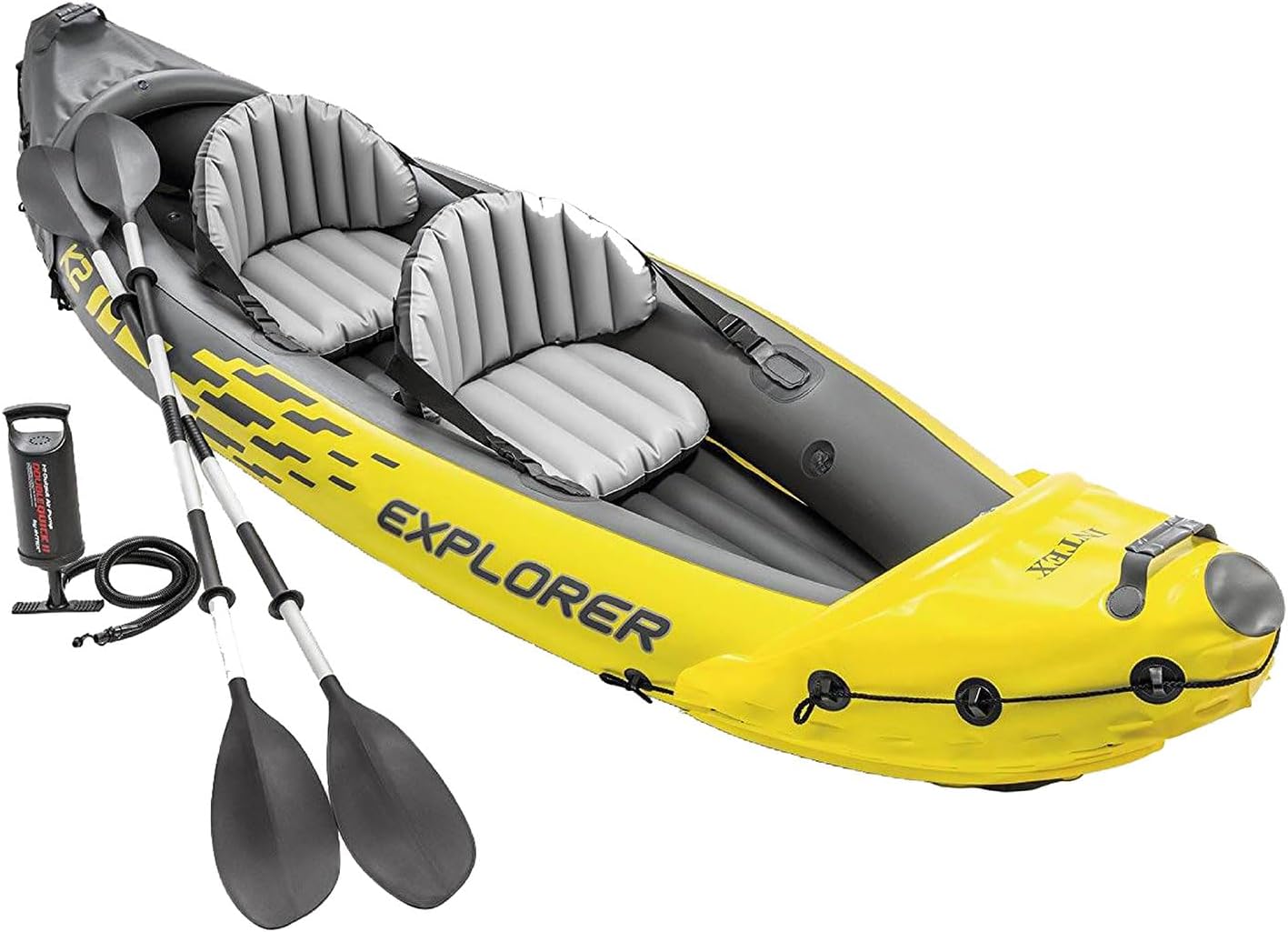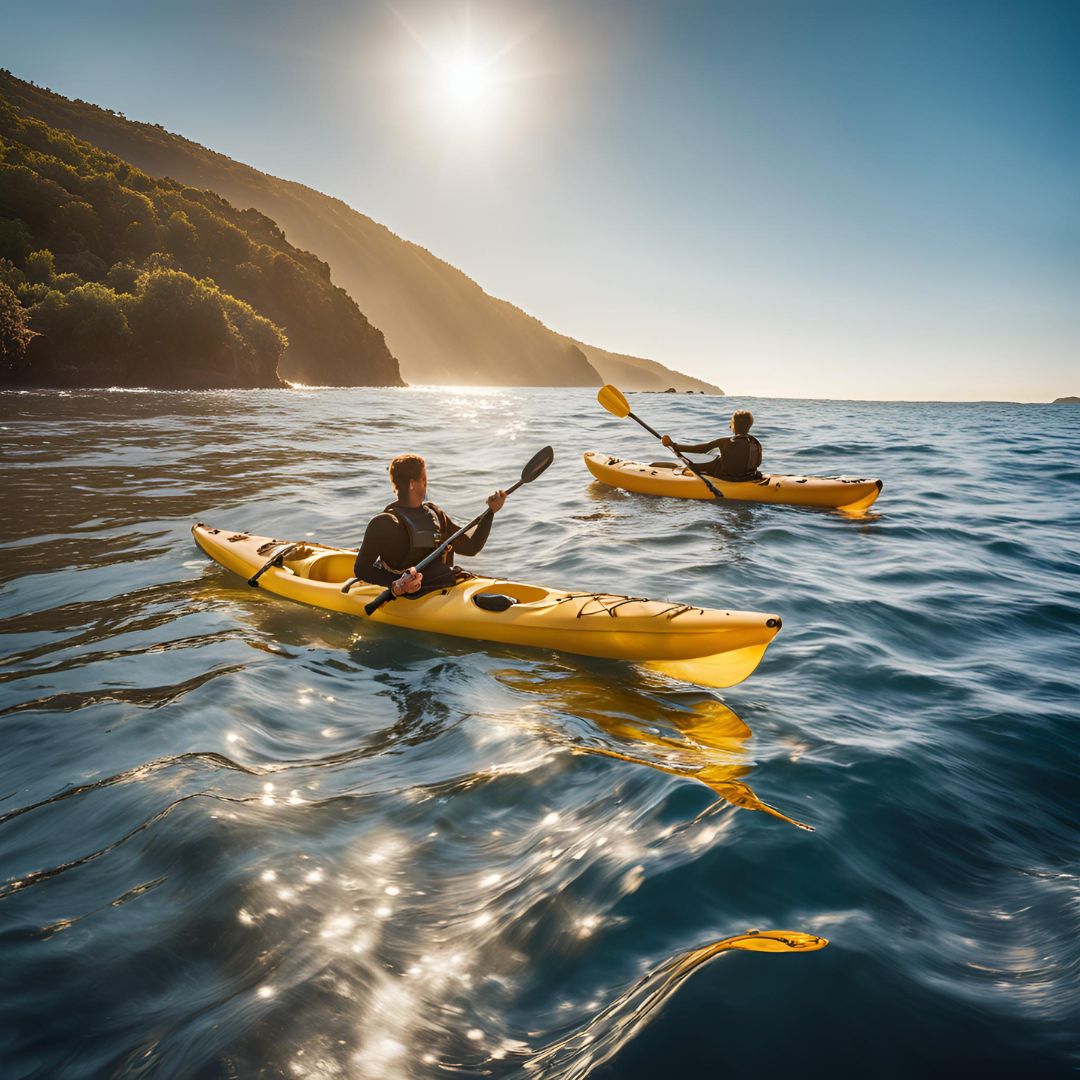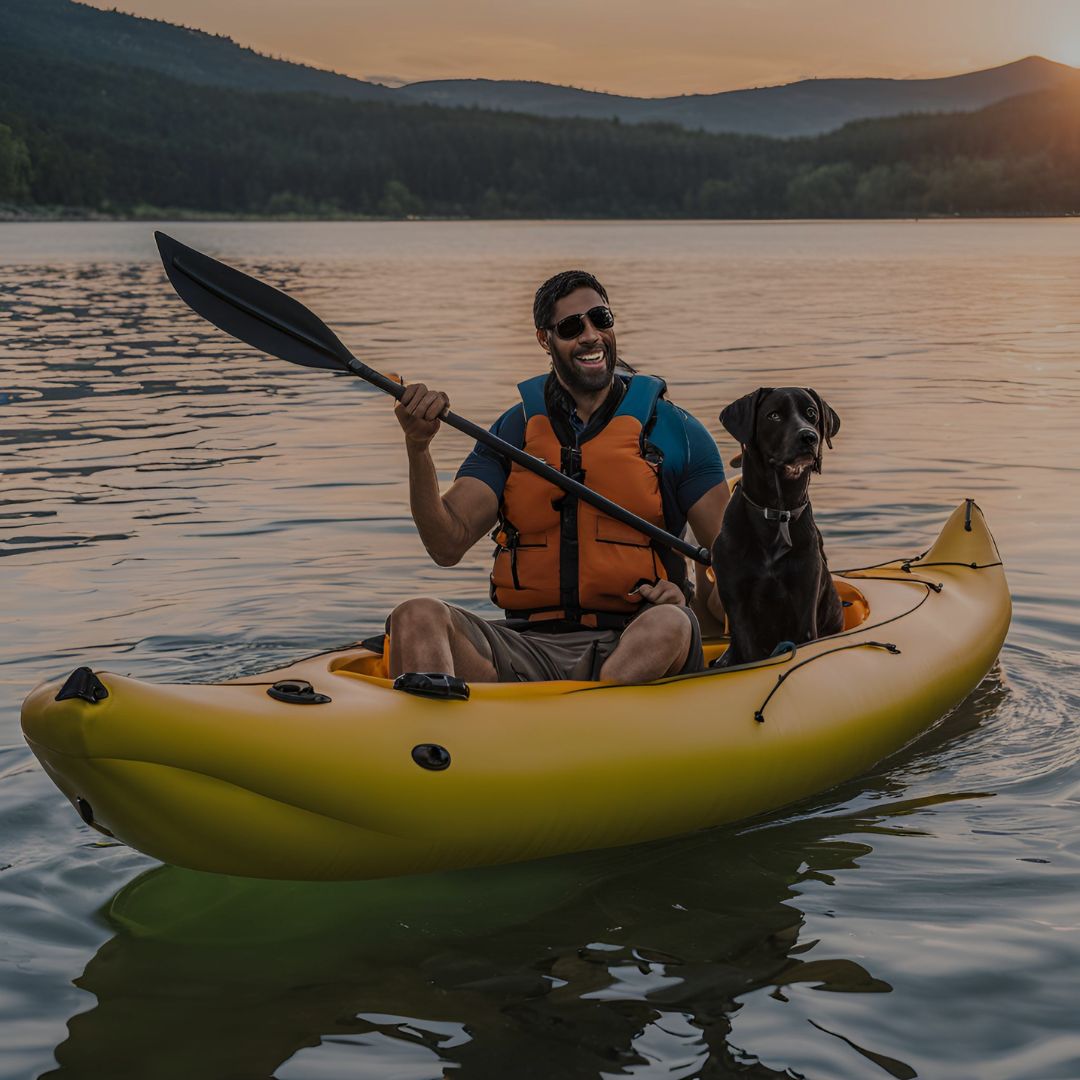Are Inflatable Kayaks Safe
Are inflatable kayaks safe? If I had a dollar for every time someone asked me that, I’d probably have enough to buy a fleet of inflatable kayaks by now! I mean, I get it.
When you think of a kayak you have to blow up, your brain probably conjures up images of beach floaties popping on a jagged rock mid-adventure. But hold on! These aren’t the flimsy pool toys from your childhood. Inflatable kayaks have seriously leveled up.
Now, let’s talk about why they’re way tougher than you might think – and why you won’t be swimming home with a deflated kayak slung over your shoulder.
Are Inflatable Kayaks Safe?
Yes. Inflatable kayaks are safe, and here’s why.
First off, they’re built from military-grade materials like PVC and Hypalon – stuff you could probably use to shield yourself from an alien invasion. Okay, maybe not aliens, but they do hold up against rocks, sticks, and other natural hazards like champions.
Many models even use drop-stitch technology, which makes the kayak as firm as a hard-shell when fully inflated. So, unless you’re kayaking through a field of nails (which I don’t recommend), you’ll be just fine.
And here’s the real kicker: inflatable kayaks often have multiple air chambers. That means if you do somehow manage to puncture one, you’re not going to sink like a stone.
You’ll still have other chambers to keep you afloat long enough to paddle back to safety. Think of it as the kayak version of having a spare tire, but way more important because, you know, water and all.
Now that we’ve established inflatable kayaks are safe, let’s break down some of the concerns people have and how modern inflatable kayaks address them. This way, you can paddle out with peace of mind (and maybe show off to your skeptical friends when they see your sleek, trusty vessel).
1. Durability: “But What If I Hit a Rock?”
This is the big one. No one wants to find themselves in a kayak that deflates faster than a cheap air mattress. The good news is that inflatable kayaks are designed to be good and incredibly durable. Manufacturers are using materials that could probably survive your cat’s claws – yes, that durable.
The key to their toughness lies in multi-layer construction. Inflatable kayaks typically have multiple layers of thick, puncture-resistant material like PVC or Hypalon, the same stuff used in whitewater rafts and even military-grade inflatable boats.
It means these things are made to take a beating. Some models, especially those using drop-stitch technology, can even feel rock solid when inflated properly.
You can bump into rocks, scrape against branches, or even drag your kayak onto a rocky shore, and it’s not going to pop like a balloon. It’s designed to handle the rough stuff.
So How Do You Know It’s Safe?
Look for features like reinforced seams and abrasion-resistant bottoms. The best inflatable kayaks, like those from Advanced Elements or Sea Eagle, are built with durability in mind. These kayaks can withstand the elements without batting an eye (or popping an air chamber).
RELATED: Does Heat Gun Speed Up Adhesive Cure Time Inflatable Kayak
2. Performance in Rough Waters: Will It Hold Up?
Alright, so we’ve covered durability, but what about performance? Can you trust an inflatable kayak in, let’s say, a river with rapids or some choppy waves?
Good news: inflatable kayaks have come a long way in the performance department too. Thanks to design improvements, they’re not just meant for calm lakes anymore. Modern inflatables are built with wider bases, which give them amazing stability. In fact, some models are so stable that you could probably stand up and paddleboard on them (though I’d recommend practicing that on a calm day).
In rough waters, features like self-bailing holes (which let water drain out), removable skegs, and high sides make these kayaks perform like champs. You’re less likely to capsize, and even if water splashes into your boat, it won’t turn into an impromptu swimming pool.
Take the Intex Excursion Pro – this is a favorite among paddlers who like to hit slightly more adventurous spots.
Users have reported paddling through Class II rapids with ease, thanks to its rigid floor and removable skegs for improved tracking. So yes, inflatable kayaks can handle more than just tranquil waters. They’ve proven themselves in whitewater too.
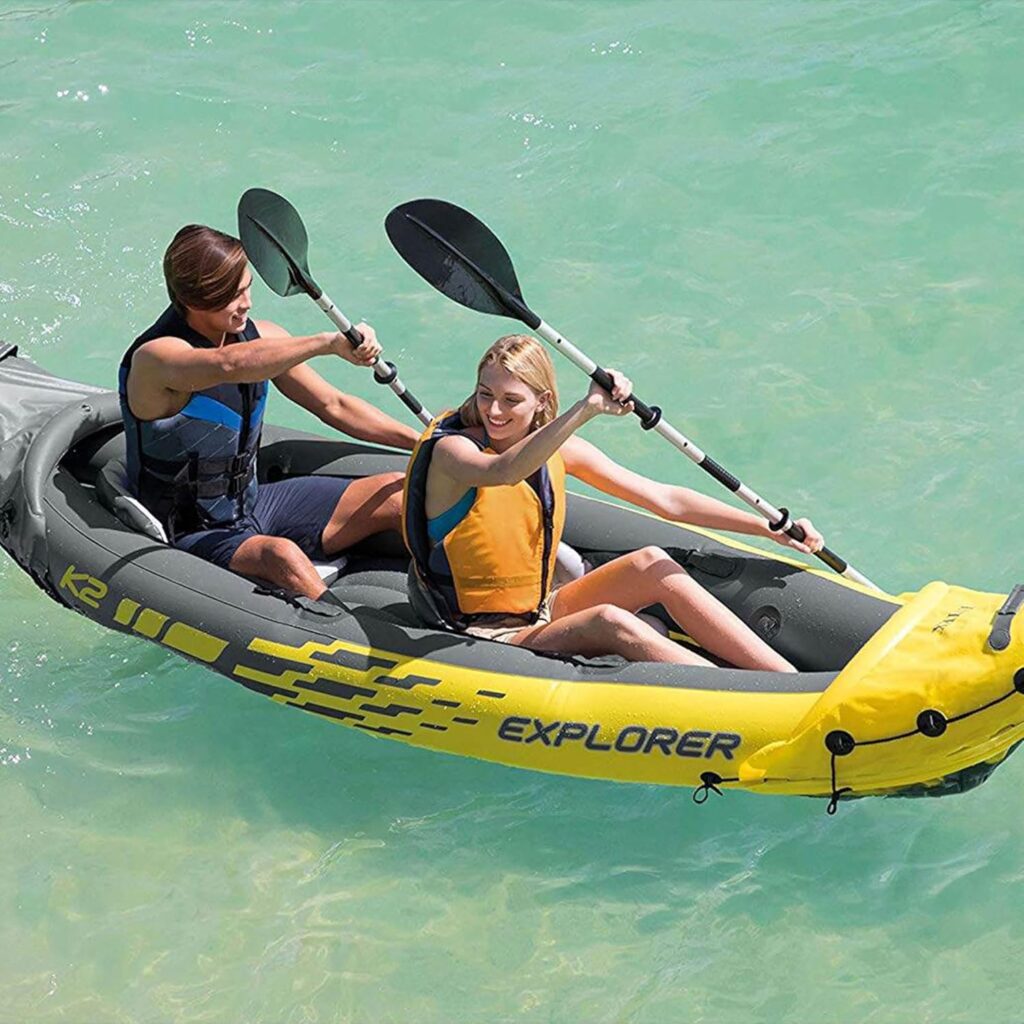
3. Puncture and Air Leak Concerns: What If It Deflates Mid-Paddle?
If you’re still worried about your kayak deflating mid-trip, don’t be. I mean, sure, if you kayak into a sharp object at full speed, you might get a hole—but these kayaks are designed to prevent catastrophic failures.
Most inflatable kayaks have multiple air chambers, so even if one gets punctured, the others will keep you afloat. You’re not going to end up stranded in the middle of the lake. Plus, high-quality valves (like Boston valves or double-lock valves) keep the air in tight, preventing any slow leaks.
But just to give you some peace of mind, it’s always smart to carry a repair kit. Repair kits are like having a Band-Aid for your kayak, and modern kits can patch a hole so quickly and effectively that you won’t miss a beat in your adventure.
Choose kayaks with double-layer floors or reinforced seams if you’re especially concerned about punctures. The Sea Eagle 370 is known for being nearly indestructible, built with K80 PVC, and reviewers rave about how it’s survived everything from sharp rocks to heavy fishing gear.
4. Performance vs. Hard-Shell Kayaks: Can an Inflatable Keep Up?
I know what you’re thinking. “Sure, it’s safe. But can it perform as well as a traditional hard-shell kayak?” The answer: Yes, it can – especially if you’re not entering the Olympics.
Inflatable kayaks have come a long way in terms of performance. Thanks to innovations like high-pressure inflation and drop-stitch technology, these kayaks can be inflated to a high PSI, making them rigid enough to perform like a hard-shell. You won’t get that floppy, wobbly feeling you might associate with inflatables from years ago.
Many models also come with removable skegs or tracking fins, which help the kayak glide straight through the water. This is particularly helpful if you’re planning a longer trip or paddling in open water where straight tracking is essential.
Take the Aquaglide Navarro 145 – this inflatable is so sleek, it rivals hard-shell kayaks in speed and agility. It’s a favorite among touring enthusiasts, offering excellent tracking, stability, and comfort on long paddles. You won’t feel like you’re sacrificing performance for portability with this one.
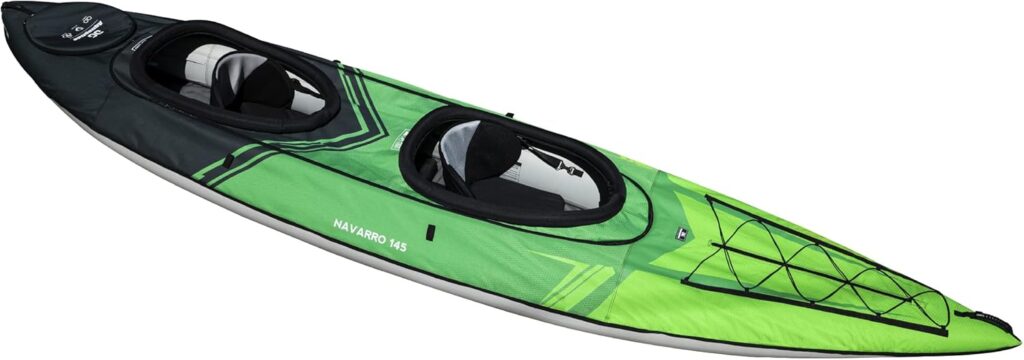
5. Are Inflatable Kayaks Safe for Beginners?
If you’re new to kayaking, you might be wondering whether an inflatable kayak is a good choice for your first trip out on the water. Spoiler alert: It’s actually a fantastic option.
Inflatable kayaks are extremely stable, thanks to their wide design. They’re harder to tip over than some narrow hard-shells, making them an ideal choice for beginners who want a forgiving learning curve. Plus, they’re much lighter and easier to carry, so you won’t be sweating bullets just getting it to the water.
Another perk for beginners is the easy setup. Most inflatable kayaks come with a pump, and within 10 minutes, you’re ready to go. You won’t spend an hour trying to strap a heavy kayak onto the roof of your car. Just deflate it when you’re done, pack it into its bag, and you’re off.
The Advanced Elements Island Voyage 2 is a top pick for newbies. It’s super easy to inflate and incredibly stable, giving first-timers the confidence they need to enjoy their kayaking experience without any added stress.
6. Portability vs. Safety: Can Something So Easy to Transport Be Safe?
One of the best things about inflatable kayaks is their portability. You can roll them up and toss them in your trunk, backpack, or even check them on a plane. But does this convenience come at the cost of safety?
Absolutely not. Just because a kayak is portable doesn’t mean it’s cutting corners on safety. Many inflatables come with grab handles, high-visibility colors, and even reflective strips to make them safer on the water. These features make it easier to handle in case of an emergency, plus the bright colors ensure you’re visible to others out on the water.
And while inflatables are easier to store and transport, their multiple air chambers and reinforced designs make sure that once you’re out on the water, you’re just as safe as in a hard-shell kayak.
The Sea Eagle 330 is a highly portable option that doesn’t compromise on safety. Weighing just 26 pounds, it’s still sturdy enough to support up to 500 pounds. It’s a great pick for adventurers who want a packable kayak without sacrificing security or performance.
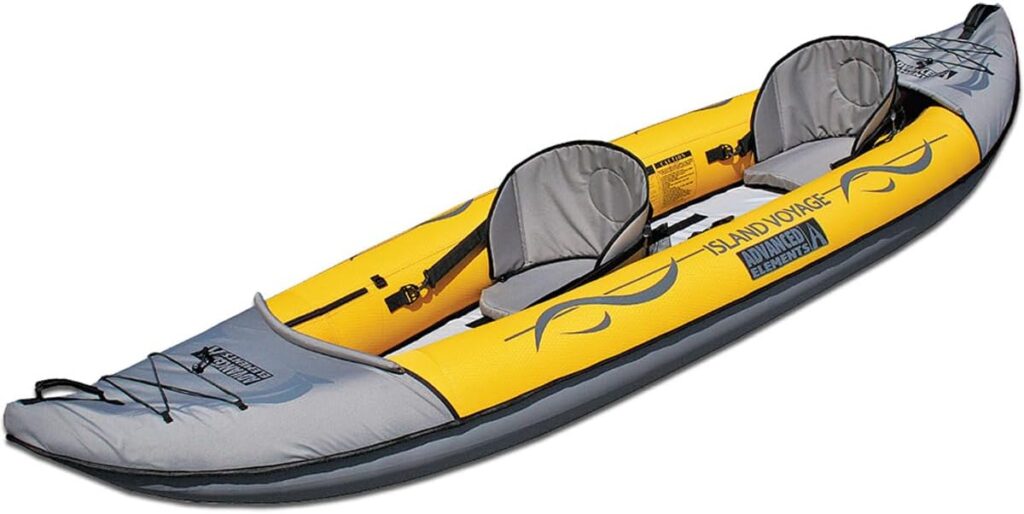
Tips for Keeping Your Inflatable Kayak Safe
Here are some pro tips to make sure your inflatable kayak stays safe for the long haul:
- Inspect Before Each Use: Just like you’d check your tires before a road trip, give your inflatable kayak a quick inspection. Look for any small punctures or areas that need patching before heading out. This ensures you won’t get any unpleasant surprises once you’re in the water.
- Proper Inflation: Over or under-inflating your kayak can affect its performance and durability. Follow the manufacturer’s recommended PSI levels. A well-inflated kayak provides better tracking, stability, and resistance to punctures. Plus, it just feels better to paddle!
- Avoid Dragging: While modern inflatable kayaks are tough, dragging them over sharp rocks or rough surfaces can wear them down over time. Carry your kayak when moving it on land or invest in a portage cart for easier transport.
- Store It Properly: When you’re done with your adventure, dry the kayak thoroughly before packing it away. Storing a damp kayak can lead to mildew or weakening of the material. Also, keep it in a cool, dry place away from direct sunlight, which can degrade the material over time.
- Use a Skeg or Tracking Fin: If you’re paddling in open water or windy conditions, attaching a skeg or tracking fin can make a world of difference in performance. It helps your kayak glide straight and reduces the amount of zigzagging you’ll have to correct.
- Invest in a Good Paddle: It might seem unrelated to safety, but a high-quality paddle can significantly improve your control over the kayak, especially in challenging conditions. Better control = fewer accidents.
The Bottom Line on Are Inflatable Kayak Safe
In summary, the question “Are inflatable kayaks safe?” can confidently be answered with a resounding yes. Thanks to modern advancements in materials and design, inflatable kayaks are durable, reliable, and safe for paddlers of all levels. From calm lakes to more adventurous waters, they offer the stability and protection you need to enjoy your time on the water without worry.
Whether you’re a beginner looking for a lightweight, easy-to-use kayak or a seasoned paddler who wants the convenience of portability without compromising safety, an inflatable kayak can meet your needs. So the next time you hear someone questioning whether inflatable kayaks are safe, you can tell them, with confidence (and maybe a smirk), that they are. And then, go hit the water to prove it!
Just remember: choose a reputable brand, follow the guidelines, and take care of your inflatable kayak, and it’ll take care of you. Paddle on, my friend, paddle on.
